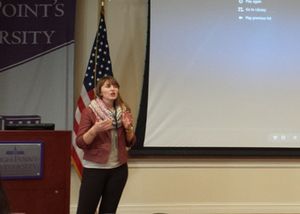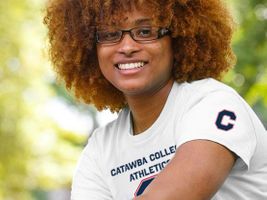
Several students and faculty from Catawba College attended and presented their work at the N.C. Undergraduate Research and Creativity Symposium (SNCURCS) on November 14, 2015, at High Point University.
The SNCURCS hosts the annual symposium so that students from all fields in higher education in North Carolina can share the results of their research and creative works. These students make presentations, give talks, and showcase their art through various performance media.
Senior literature major Ashley Everidge of Hamptonville presented a video production titled, “Cather’s Indefinite Decision.” Conceived of in Dr. Forrest Anderson’s course on the American Novel at Catawba, Everidge’s project examined the role of land in Willa Cather’s A Lost Lady (1923).
Dr. Carmony Hartwig, an assistant professor of Biology, had three senior student researchers present their work at the conference. Nadine Brockmann of Hamburg, Germany, and Virginia Merida of Candor, posed an interesting question regarding the human microbiome – Does regular exercise affect the composition and abundance of bacterial species on the human skin? To address this question the two designed a project to look at the belly button bacteria diversity between athletes and non-athlete populations from Catawba College, and they presented their experimental findings at the symposium with their presentation entitled Exploring Bacterial Diversity in Student Athletes: Implications for Skin and Organismal Health. Fernando Guerrero Nava of Kannapolis presented a poster on his study exploring the mechanism of the potent antimalarial artemisinin via an in vitro assay system entitled Investigating the Mechanism of Heme-activated Artemisinin Metabolites through a Lipid-Based in vitro Assay. The assay results in a fluorescent product which is yet to be identified and if identified, could help with isolating the mechanism of action by which artemisinin is able to kill malaria parasites. Nava’s work provides further supportive evidence for lipid peroxidation as a potential pathway of artemisinin activity in the malarial parasite.
Dr. Connie Lowery, an associate professor and chair of Catawba’s Biology Department, and Dr. Jay Bolin, an assistant professor of Biology, accompanied their students to the SNCURSCS conference. Several students from the Biology Capstone class gave talks describing their capstone research. These include Johnathon Boles of Salisbury, whose talk is Common Oat: A Potential Wound Healing Promoter; Allison Baucom of Salisbury on Raspberries: Harvest to Health; Comparison of soluble sugar content, pH, anthocyanin, and phenolic content in red, yellow, and black raspberries; Matthew Jordan-Steele of Lexington on Phenomenal Phenolics: An Association Study of Avenanthramide and Tocopherol in Avena sativa; and James Lohr of Salisbury, who presented his talk Preparation Methods on the Differential Accumulation of Metabolites in Brassica Oleracea subsp. Italic
Dr. ChaMarra Saner, an assistant professor of Chemistry, has mentored Maria Gurski of Norristown, Pa., whose talk is titled How HuR and CP1 are Affected By KRas and Stressors in Pancreatic Cancer Cells. Her talk focused on how KRas, a signaling enzyme, is mutated and in turn activated in over 90% of pancreatic cancer cases. HuR is upregulated and causes the growth and spread of cancer by regulating cancer related genes. This project investigates if KRas and/or stressors regulate HuR and its cleaved product, CP1.
Three psychology students of Dr. Sheila Brownlow, a professor and chair of Psychology, presented the results of their junior-year psychology research. Grace Tworek of Spruce Grove, Alberta, Canada, created a poster, Active vs. Passive Language Use in APA-Style Writing, which examines how scientific writing style influences views of authors and topics when compared to first-person, active writing. Erich Guebert of Martinsville, Va., presented Name-Letter Matching After Cognitive Depletion, which reports his study on how cognitive tasks ego-depleted people and resulted in changes to self-enhancement strategies. Finally, Kathleen Burris of Mt. Pleasant presented her Alpha Chi award-winning poster titled Media Influences on Beliefs About Fitness and Exercise, a study that examined how brief exposures to media promoting reasonable views of fitness can have positive effects on both men and women.
